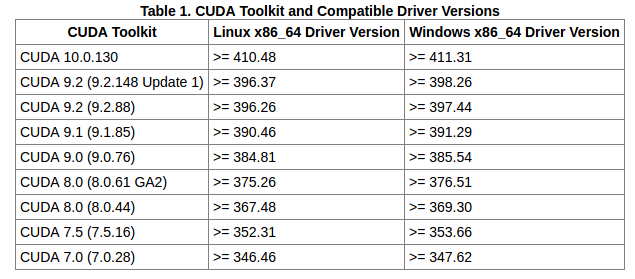-
Computer:
- For reference, we use e.g. Dell workstations (79xx series) with Ubuntu 16.04 LTS and run a Docker container that has TensorFlow, etc. installed (https://github.com/MMathisLab/Docker4DeepLabCut2.0).
-
Computer Hardware:
- Ideally, you will use a strong GPU with at least 8GB memory such as the NVIDIA GeForce 1080 Ti. A GPU is not necessary, but on a CPU the (training and evaluation) code is considerably slower (100x). You might also consider using cloud computing services like Google cloud/amazon web services.
-
Camera Hardware:
- The software is very robust to track data from pretty much any camera (grayscale, color, or graysale captured under infrared light etc.). See demos on our website
-
Software:
- Operating System: Linux (Ubuntu 16.04 LTS), MacOS* (Mojave), or Windows 10. However, the authors strongly recommend Ubuntu! *MacOS does not support NVIDIA GPUs (easily), so we only suggest this option for CPU use or a case where the user wants to label data, refine data, etc and then push the project to a cloud reseoure for GPU computing steps.
- Anaconda/Python3: Anaconda: a free and open source distribution of the Python programming language (download from: \https://www.anaconda.com/). DeepLabCut is written in Python 3 (https://www.python.org/) and not compatible with Python 2.
- pip install deeplabcut (see below!)
- TensorFlow (see below!)
- You will need TensorFlow (we used version 1.0 in the paper, later versions also work with the provided code (we tested TensorFlow versions 1.0 to 1.4, 1.8 to 1.12) for Python 3 with GPU support.
- To note, is it possible to run DeepLabCut on your CPU, but it will be VERY slow (see: Mathis & Warren). However, this is the preferred path if you want to test DeepLabCut on your data before purchasing a GPU, with the added benefit of a straightforward installation!
- Docker: We highly recommend using the supplied Docker container. NOTE: this container does not work on windows hosts!
There are several modes of installation, and the user should decide to either use a system-wide (see note below) or Anaconda environment based installation (recommended), or the supplied Docker container (recommended for Ubuntu advanced users).
All the following commands will be run in the app terminal in Ubuntu/MacOS, and called cmd in Windows. Please first open the terminal (search terminal or cmd).
Anaconda is perhaps the easiest way to install Python and additional packages across various operating systems. First create an Anaconda environment. With Anaconda you create all the dependencies in an environment on your machine by running in a terminal:
MacOS (Mojave+/CPU only):
- We provide environment files for MacOS. This can be installed by typing (from the terminal, within in this conda-environments folder):
conda env create -f dlc-macOS-CPU.yaml
Windows:
- We provide environment files for Windows. They can be installed by typing (from the terminal, within in this conda-environments folder):
conda env create -f dlc-windowsCPU.yamlorconda env create -f dlc-windowsGPU.yamlfor the GPU version. See further details in this issue.
LINUX (Ubuntu 16.04):
conda create -n <nameyourenvironment> python=3.6
activate <nameyourenvironment>
Once the environment was activated, the user can install DeepLabCut. In the terminal type:
pip install deeplabcut
- if you have ever used pip to install deeplabcut (or other packges), use
--ignore-installedto be sure you are grabbing the latest! i.e.pip install --ignore-installed deeplabcut
Then,
Windows: pip install -U wxPython
Linux: pip install https://extras.wxpython.org/wxPython4/extras/linux/gtk3/ubuntu-16.04/wxPython-4.0.3-cp36-cp36m-linux_x86_64.whl
As users can use a GPU or CPU, TensorFlow is not installed with the command pip install deeplabcut.
Here is more information on how to best install TensorFlow with pip: https://www.tensorflow.org/install/pip
CPU ONLY:
pip install --ignore-installed tensorflow==1.10
GPU:
Install TensorFlow. In the Nature Neuroscience paper we used TensorFlow 1.0 with CUDA (Cuda 8.0). Some other versions of TensorFlow have been tested, but use at your own risk (i.e. these versions have been tested 1.2, 1.4, 1.8 or 1.10-1.13, but might require different CUDA versions)! Please check your driver/cuDNN/CUDA/TensorFlow versions on this Stackoverflow post.
If you have a GPU, you should then install the NVIDIA CUDA package and an appropriate driver for your specific GPU. Please follow the instructions found here: https://www.tensorflow.org/install/gpu, and more tips below. The order of operations matters.
Some tips for installing TensorFlow 1.8 will follow here:
FIRST, install a driver for your GPU (we recommend the 384.xx) Find DRIVER HERE: https://www.nvidia.com/download/index.aspx
- check which driver is installed by typing this into the terminal:
nvidia-smi
SECOND, install CUDA (9.0 here): https://developer.nvidia.com/cuda-90-download-archive
THIRD, install TensorFlow:
Package for pip install:
pip install tensorflow-gpu==1.8 —with GPU support (Ubuntu and Windows)
Note, the version is specified by using: ==1.8
FOURTH, Please check your CUDA and TensorFlow installation with the lines below:
Start a python session:
ipython
import tensorflow as tf
sess = tf.Session(config=tf.ConfigProto(log_device_placement=True))
You can test that your GPU is being properly engaged with these additional tips.
TensorFlow: Here are some additional resources users have found helpful (posted without endorsement):
FFMEG:
- A few Windows users report needing to install ffmeg as described here: https://video.stackexchange.com/questions/20495/how-do-i-set-up-and-use-ffmpeg-in-windows (A potential error could occur when making new videos).
DEEPLABCUT:
- if you git clone or download this folder, and are inside of it then
import deeplabcutwill import the package from there rather than from the latest on PyPi!
If you perform the system wide installation, and the computer has other Python packages or TensorFlow versions installed that conflict, this will overwrite them. If you have a dedicated machine for DeepLabCut, this is fine. If there are other applications that require different versions of libraries, then one would potentially break those applications. The solution to this problem is to create a virtual environment, a self-contained directory that contains a Python installation for a particular version of Python, plus additional packages. One way to manage virtual environments is to use conda environments (for which you need Anaconda installed).
Now you can use Jupyter Notebooks, Spyder, and to train just use the terminal, to run all the code!
Return to readme.

